The Impacts of Vertical Off-Centring, Localiser Direction, Phantom Positioning and Tube Voltage on CT Number Accuracy: An Experimental Study
Abstract
:1. Introduction
2. Materials and Methods
2.1. Phantom and CT Protocol
2.2. CT Number and Dose Measurements
2.3. Statistical Analysis
3. Results
4. Discussion
Limitations
5. Conclusions
Author Contributions
Funding
Institutional Review Board Statement
Informed Consent Statement
Data Availability Statement
Acknowledgments
Conflicts of Interest
References
- Cool, D.; Kase, K.R.; Boice, J.D. NCRP Report no.180-management of exposure to ionizing radiation: NCRP radiation protection guidance for the United States. J. Radiol. Prot. 2019, 39, 966–977. [Google Scholar]
- Lurz, M.; Lell, M.M.; Wuest, W.; Eller, A.; Scharf, M.; Uder, M.; May, M.S. Automated tube voltage selection in thoracoabdominal computed tomography at high pitch using a third-generation dual-source scanner: Image quality and radiation dose performance. Investig. Radiol. 2015, 50, 352–360. [Google Scholar] [CrossRef] [PubMed]
- Booij, R.; Dijkshoorn, M.L.; van Straten, M. Efficacy of a dynamic collimator for overranging dose reduction in a second- and third-generation dual source CT scanner. Eur. Radiol. 2017, 27, 3618–3624. [Google Scholar] [CrossRef] [PubMed] [Green Version]
- Toth, T.L. Dose reduction opportunities for CT scanners. Pediatr. Radiol. 2002, 32, 261–267. [Google Scholar] [CrossRef] [PubMed]
- Yurt, A.; Özsoykal, İ.; Obuz, F. Effects of the Use of Automatic Tube Current Modulation on Patient Dose and Image Quality in Computed Tomography. Mol. Imaging Radionucl. Ther. 2019, 28, 96–103. [Google Scholar] [CrossRef]
- Kalender, W. Computed Tomography: Fundamentals, System Technology, Image Quality, Applications, 3rd ed.; Publicis Publishing: Erlangen, Germany, 2011. [Google Scholar]
- Habibzadeh, M.A.; Ay, M.R.; Asl, A.R.; Ghadiri, H.; Zaidi, H. Impact of miscentering on patient dose and image noise in X-ray CT imaging: Phantom and clinical studies. Phys. Med. 2012, 28, 191–199. [Google Scholar] [CrossRef] [PubMed] [Green Version]
- Aviles Lucas, P.; Dance, D.R.; Castellano, I.A.; Vano, E. Monte Carlo simulations in CT for the study of the surface air kerma and energy imparted to phantoms of varying size and position. Phys. Med. Biol. 2004, 49, 1439–1454. [Google Scholar] [CrossRef]
- Paolicchi, F.; Bastiani, L.; Negri, J.; Caramella, D. Effect of CT Localizer Radiographs on Radiation Dose Associated with Automatic Tube Current Modulation: A Multivendor Study. Curr. Probl. Diagn. Radiol. 2020, 49, 34–41. [Google Scholar] [CrossRef] [PubMed]
- Hunter, T.B.; Pond, G.D.; Medina, O. Dependence of substance CT number on scanning technique and position within scanner. Comput. Radiol. 1983, 7, 199–203. [Google Scholar] [CrossRef]
- Li, J.; Udayasankar, U.K.; Toth, T.L.; Seamans, J.; Small, W.C.; Kalra, M.K. Automatic patient centering for MDCT: Effect on radiation dose. AJR Am. J. Roentgenol. 2007, 188, 547–552. [Google Scholar] [CrossRef]
- Cropp, R.J.; Seslija, P.; Tso, D.; Thakur, Y. Scanner and kVp dependence of measured CT numbers in the ACR CT phantom. J. Appl. Clin. Med. Phys. 2013, 14, 4417. [Google Scholar] [CrossRef] [PubMed]
- Szczykutowicz, T.P.; Duplissis, A.; Pickhardt, P.J. Variation in CT Number and Image Noise Uniformity According to Patient Positioning in MDCT. AJR Am. J. Roentgenol. 2017, 208, 1064–1072. [Google Scholar] [CrossRef]
- Nelson, J.C.; Kronmal, R.A.; Carr, J.; McNitt-Gray, M.F.; Wong, N.D.; Loria, C.M.; Goldin, J.G.; Williams, O.D.; Detrano, R. Measuring coronary calcium on CT images adjusted for attenuation differences. Radiology 2005, 235, 403–414. [Google Scholar] [CrossRef]
- Albano, D.; Agnello, F.; Midiri, F.; Pecoraro, G.; Bruno, A.; Alongi, P.; Toia, P.; Di Buono, G.; Agrusa, A.; Sconfienza, L.M.; et al. Imaging features of adrenal masses. Insights Imaging 2019, 10, 1. [Google Scholar] [CrossRef] [PubMed] [Green Version]
- Hartman, D.S.; Choyke, P.L.; Hartman, M.S. From the RSNA refresher courses: A practical approach to the cystic renal mass. Radiographics 2004, 24 (Suppl. 1), S101–S115. [Google Scholar] [CrossRef] [PubMed]
- Gillies, R.J.; Kinahan, P.E.; Hricak, H. Radiomics: Images Are More than Pictures, They Are Data. Radiology 2016, 278, 563–577. [Google Scholar] [CrossRef] [Green Version]
- Escudero Sanchez, L.; Rundo, L.; Gill, A.B.; Hoare, M.; Mendes Serrao, E.; Sala, E. Robustness of radiomic features in CT images with different slice thickness, comparing liver tumour and muscle. Sci. Rep. 2021, 11, 8262. [Google Scholar] [CrossRef]
- Shafiq-ul-Hassan, M.; Latifi, K.; Zhang, G.; Ullah, G.; Gillies, R.; Moros, E. Voxel size and gray level normalization of CT radiomic features in lung cancer. Sci. Rep. 2018, 8, 10545. [Google Scholar] [CrossRef]
- Al-Hayek, Y.; Zheng, X.; Davidson, R.; Hayre, C.; Al-Mousa, D.; Finlay, C.; Spuur, K. 0° vs. 180° CT localiser: The effect of vertical off-centring, phantom positioning and tube voltage on dose optimisation in multidetector computed tomography. J. Med. Radiat. Sci. 2021, 69, 5–12. [Google Scholar]
- ImageJ Software. Available online: https://imagej.nih.gove/ij/ (accessed on 18 April 2022).
- Hsieh, J. Computed Tomography: Principles, Design, Artifacts, and Recent Advances, 3rd ed.; SPIE: Bellingham, WA, USA, 2015. [Google Scholar]
- Afifi, M.; Abdelrazek, A.; Deiab, N.A.; El-Hafez, A.I.A.; El-Farrash, A.H. The effects of CT X-ray tube voltage and current variations on the relative electron density (RED) and CT number conversion curves. J. Radiat. Res. Appl. Sci. 2020, 13, 1–11. [Google Scholar] [CrossRef] [Green Version]
- Kucuk, N.; Tumsavas, Z.; Cakir, M. Determining photon energy absorption parameters for different soil samples. J. Radiat. Res. 2013, 54, 578–586. [Google Scholar] [CrossRef] [Green Version]
- Schröder, C.; Engenhart-Cabillic, R.; Kirschner, S.; Blank, E.; Buchali, A. Changes of lung parenchyma density following high dose radiation therapy for thoracic carcinomas—An automated analysis of follow up CT scans. Radiat. Oncol. 2019, 14, 72. [Google Scholar] [CrossRef]
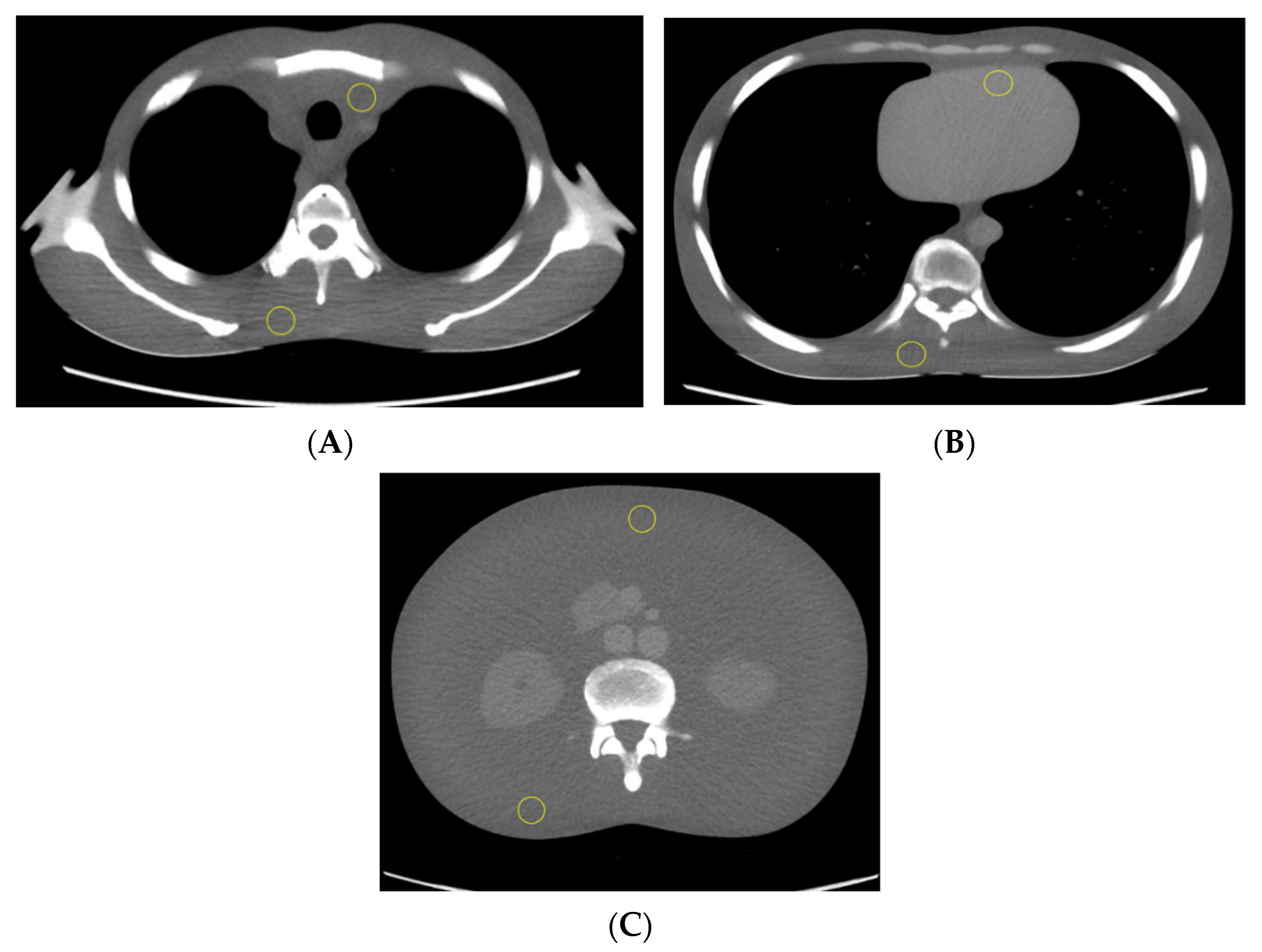
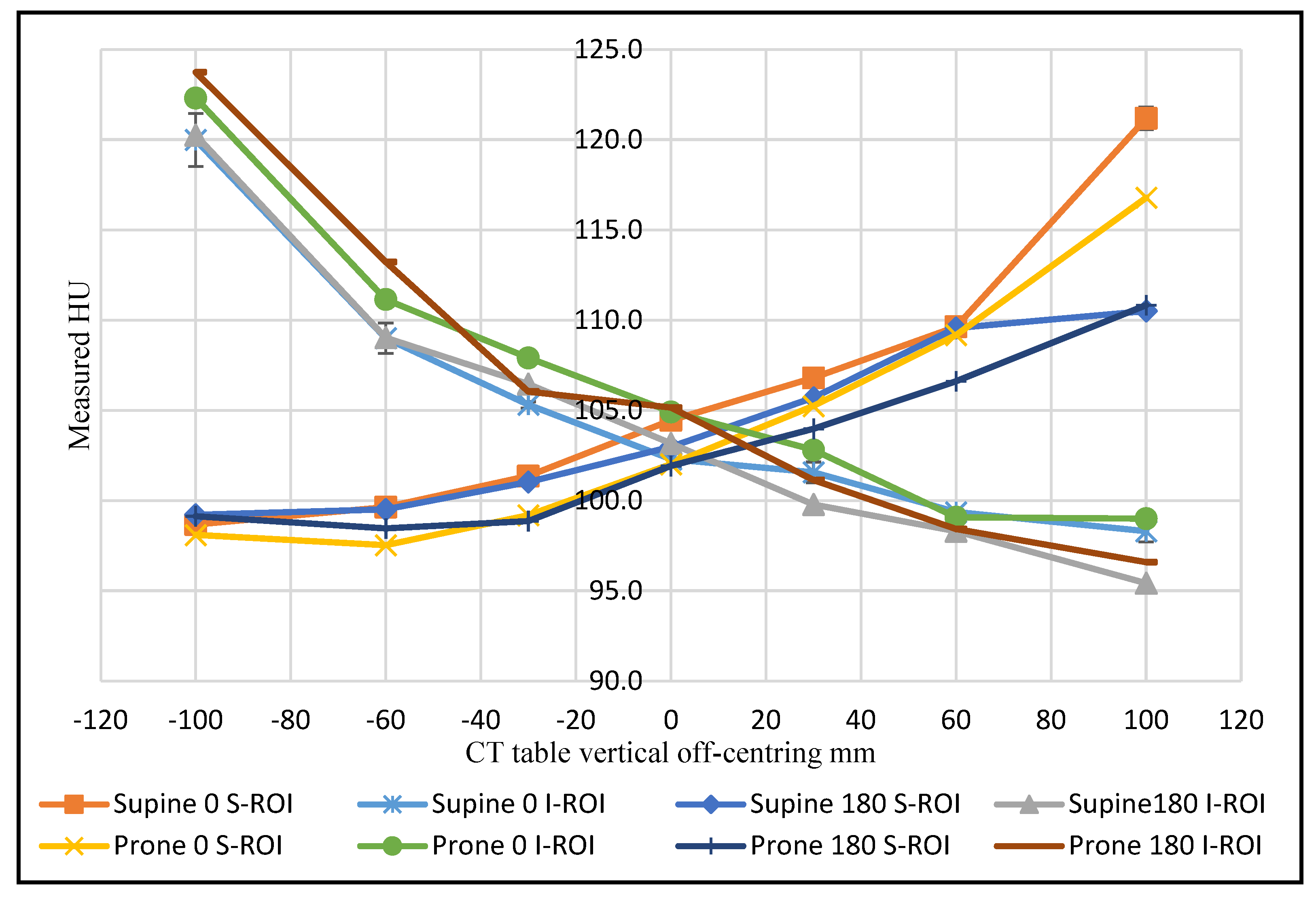

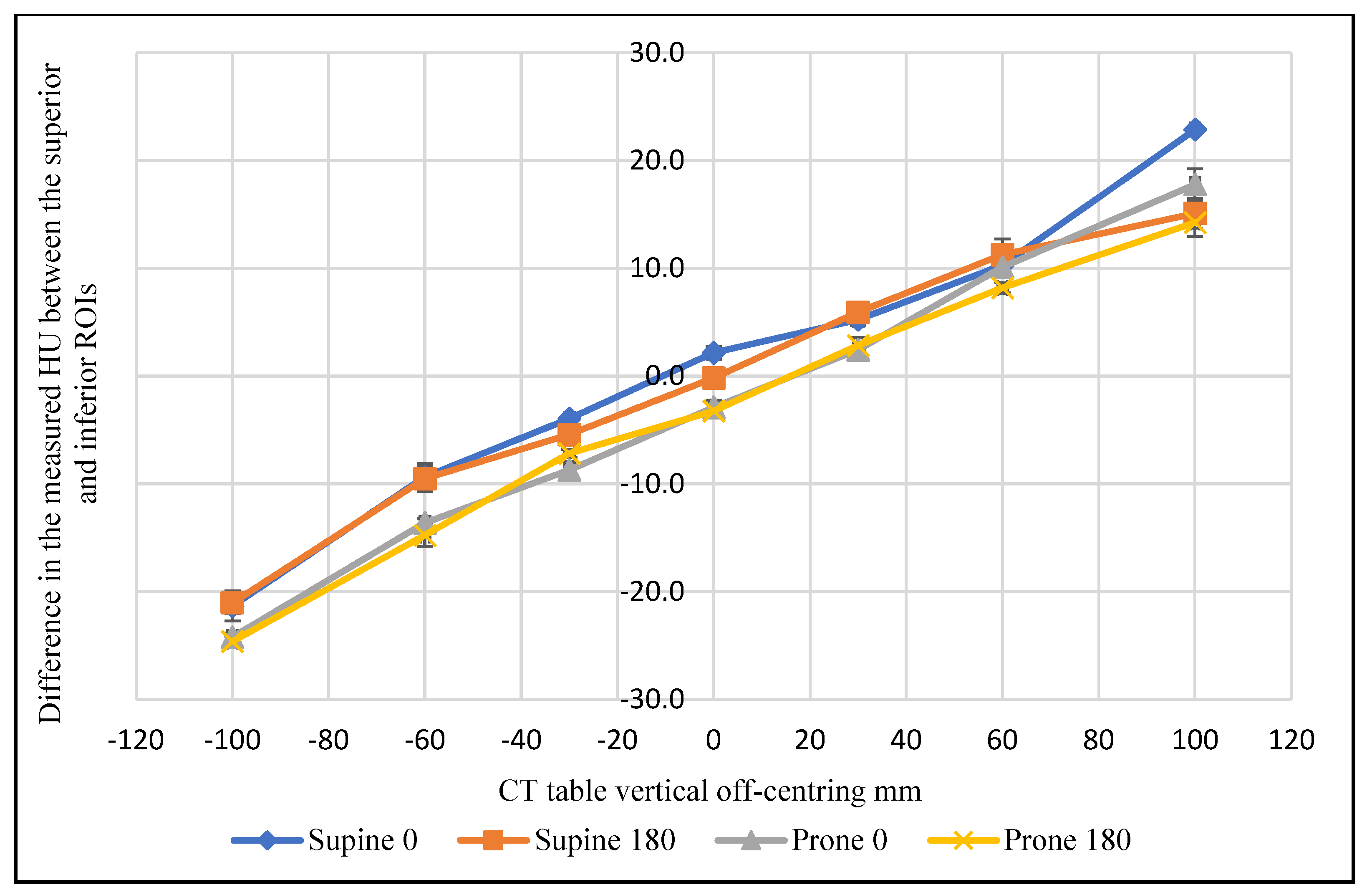
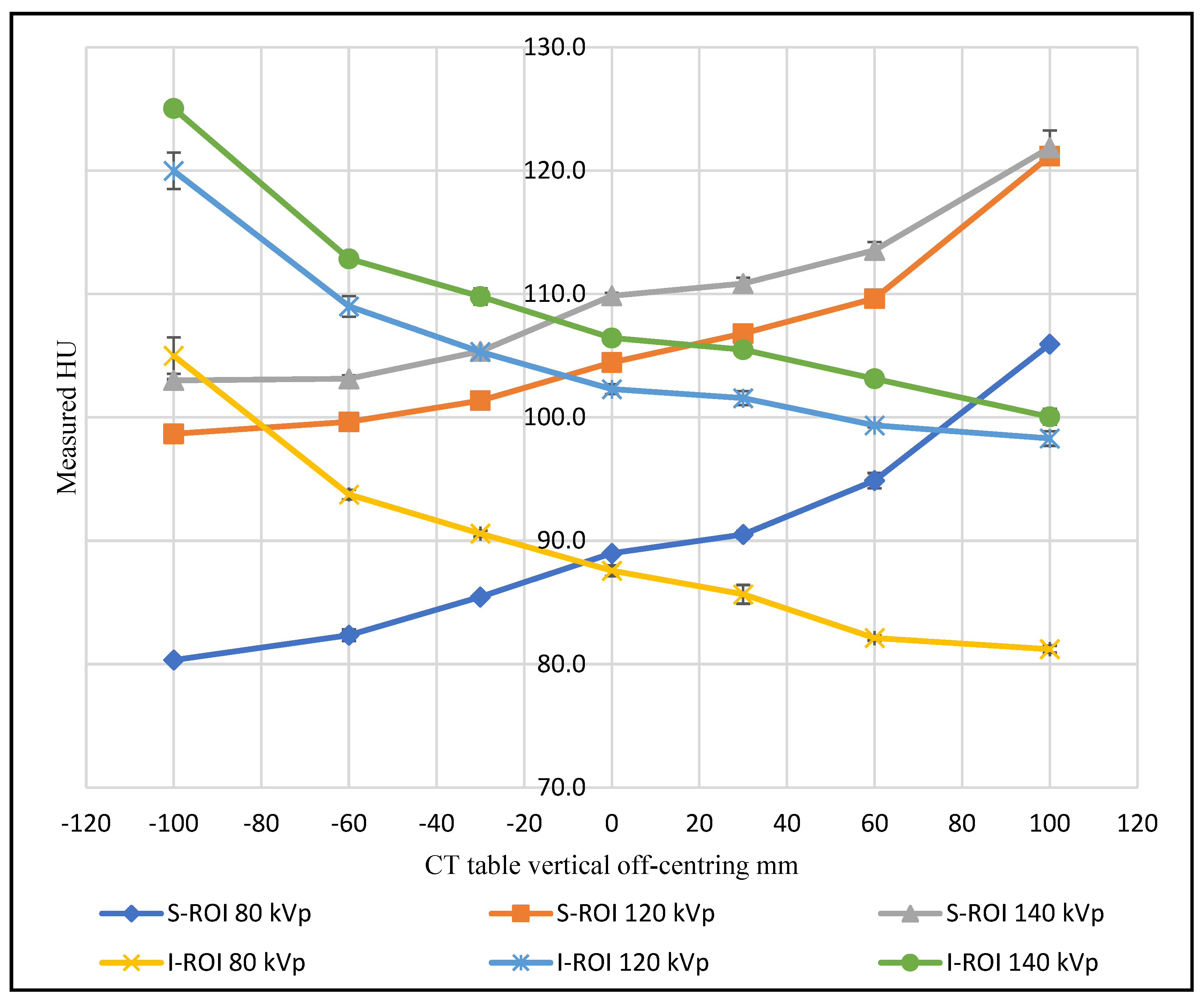
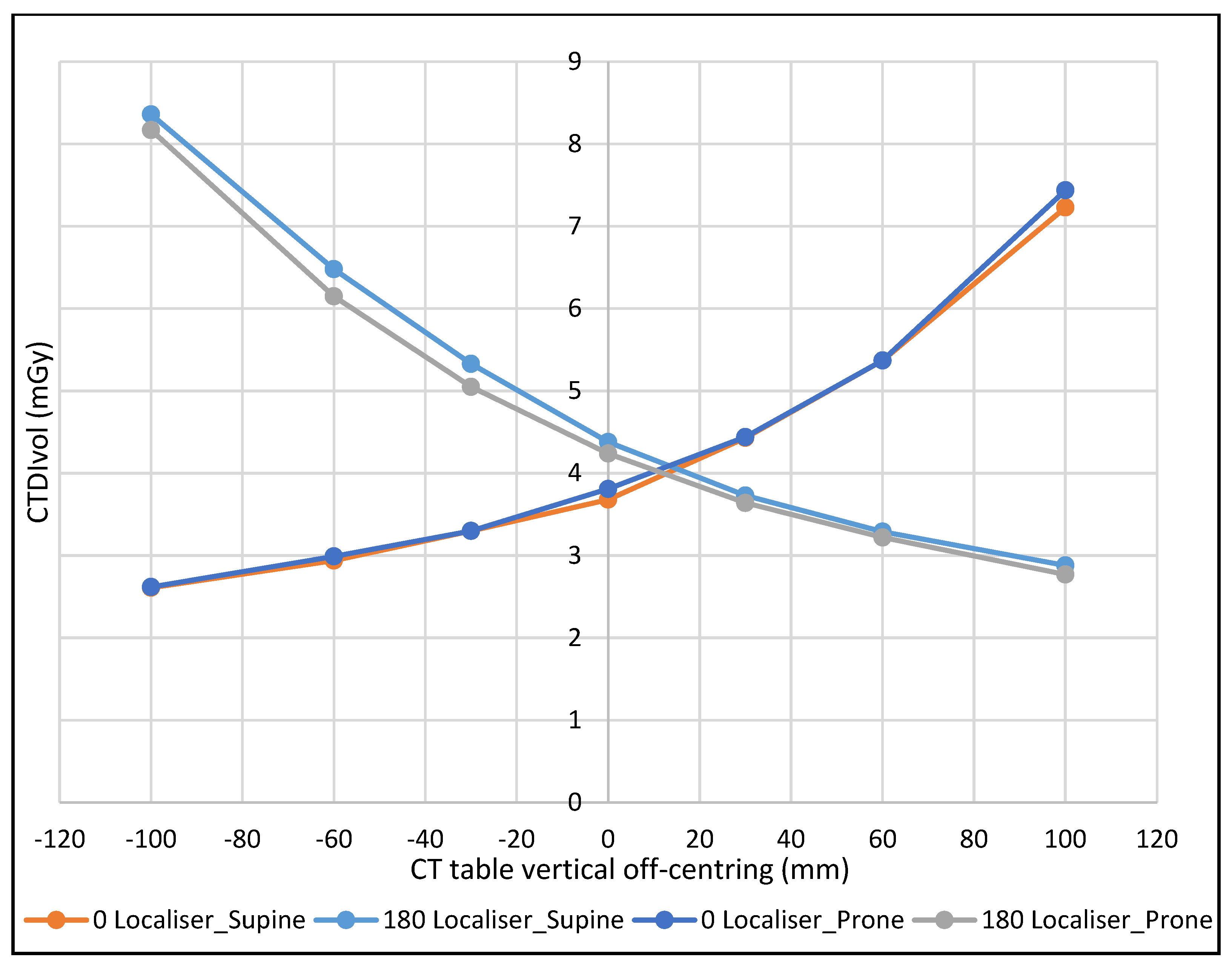
| 80 kVp | 120 kVp | 140 kVp | |||||
|---|---|---|---|---|---|---|---|
| S.ROI a | I.ROI b | S.ROI | I.ROI | S.ROI | I.ROI | ||
| 0° localiser/Supine position | Upper Thorax | 29 | 10.8 | 4.3 | 33.6 | 0.5 | 27.9 |
| Mid Thorax | 6.1 | 28.3 | 3.5 | 26.0 | 4.2 | 29.1 | |
| Abdomen | 25.6 | 23.8 | 22.5 | 21.7 | 18.9 | 25.0 | |
| 180° localiser/Supine position | Upper Thorax | 8.7 | 27.6 | 1.4 | 23.0 | 1.5 | 21.0 |
| Mid Thorax | 2.8 | 43.3 | 2.5 | 31.4 | 1.6 | 29.3 | |
| Abdomen | 14.3 | 23.5 | 12.0 | 24.8 | 12.4 | 23.0 | |
| 0° localiser/Prone position | Upper Thorax | 17.7 | 0.9 | 6 | 4.0 | 19.5 | 7.4 |
| Mid Thorax | 33.1 | 0.1 | 23.4 | 0.1 | 21.0 | 10.4 | |
| Abdomen | 22.5 | 30.8 | 18.7 | 23.3 | 17.4 | 28.5 | |
| 180° localiser/Prone position | Upper Thorax | 10.9 | 7.0 | 17.2 | 2.9 | 12.2 | 4.0 |
| Mid Thorax | 15.9 | 15.4 | 14.8 | 13.9 | 13.5 | 9.9 | |
| Abdomen | 14.6 | 29.0 | 11.7 | 27.2 | 12.4 | 32.1 | |
Publisher’s Note: MDPI stays neutral with regard to jurisdictional claims in published maps and institutional affiliations. |
© 2022 by the authors. Licensee MDPI, Basel, Switzerland. This article is an open access article distributed under the terms and conditions of the Creative Commons Attribution (CC BY) license (https://creativecommons.org/licenses/by/4.0/).
Share and Cite
Al-Hayek, Y.; Spuur, K.; Davidson, R.; Hayre, C.; Zheng, X. The Impacts of Vertical Off-Centring, Localiser Direction, Phantom Positioning and Tube Voltage on CT Number Accuracy: An Experimental Study. J. Imaging 2022, 8, 175. https://doi.org/10.3390/jimaging8070175
Al-Hayek Y, Spuur K, Davidson R, Hayre C, Zheng X. The Impacts of Vertical Off-Centring, Localiser Direction, Phantom Positioning and Tube Voltage on CT Number Accuracy: An Experimental Study. Journal of Imaging. 2022; 8(7):175. https://doi.org/10.3390/jimaging8070175
Chicago/Turabian StyleAl-Hayek, Yazan, Kelly Spuur, Rob Davidson, Christopher Hayre, and Xiaoming Zheng. 2022. "The Impacts of Vertical Off-Centring, Localiser Direction, Phantom Positioning and Tube Voltage on CT Number Accuracy: An Experimental Study" Journal of Imaging 8, no. 7: 175. https://doi.org/10.3390/jimaging8070175
APA StyleAl-Hayek, Y., Spuur, K., Davidson, R., Hayre, C., & Zheng, X. (2022). The Impacts of Vertical Off-Centring, Localiser Direction, Phantom Positioning and Tube Voltage on CT Number Accuracy: An Experimental Study. Journal of Imaging, 8(7), 175. https://doi.org/10.3390/jimaging8070175






